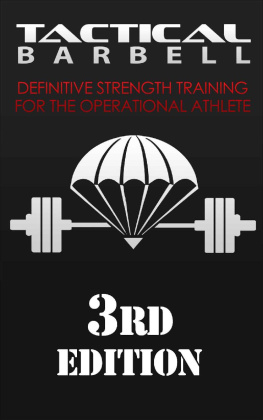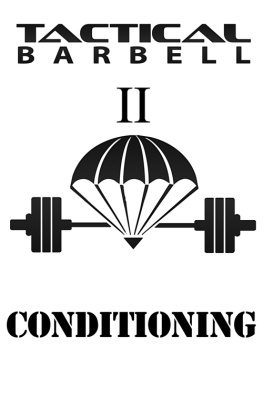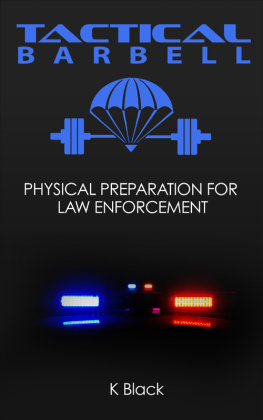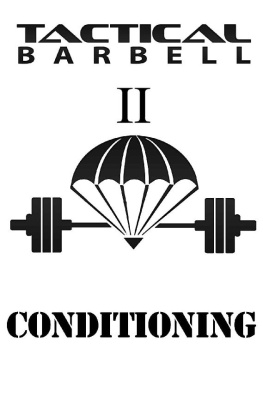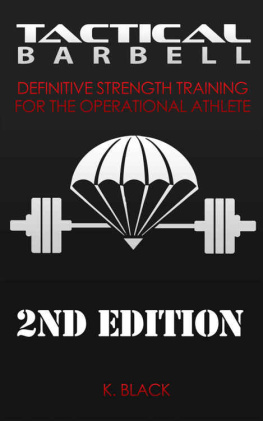Origins

Author
Congratulations on saving years of wasted time and effort in achieving your strength goals. To borrow an overused cliche, this is truly the program I wish I had when I started on the path to tactical fitness.
This book is for the man or woman that wants raw useable strength and durability WITHOUT sacrificing athletic ability. This is for you if want a program with measurable results that doesnt require you to spend hours under the barbell to the detriment of your other physical attributes. I wrote this to provide military, SWAT, and first responder types with a definitive strength program to incorporate into training. Due to time demands and the variety of skills required, an operator cant train like a powerlifter, and cant be sore for a week recovering from leg day. At the same time, maximal-strength is a major requirement that cant be ignored. Tactical athletes have to become experts at everything, which can be a juggling act. This book will deal with giving you the piece that is strength, in a way that doesnt force you to specialize or neglect your other skills.
This book is primarily aimed at those in the operational arena, but its also for the general training enthusiast, weekend warrior, or fitness fanatic that wants a hard, muscular physique that delivers real world strength. Athletes or those preparing for an event will find a customizable approach that can be used annually or seasonally in block-fashion.
A SWAT operator may have to breach a fortified drug house, run behind a police dog, and wrestle with bad guys, all while wearing heavy body armor and carrying cumbersome gear. Infantry soldiers have to patrol dozens of miles in unforgiving terrain carrying up to 100lbs of kit or more, and then conduct gruelling house to house combat. While sleep deprived and fatigued. We all know how physical a firefighters job can be, posing for calendars and preparing the barbeque (I kid).
This is NOT a cookie cutter program. There are simple, definitive pieces that you can move around and incorporate within your lifestyle and current training. Many tactical types train a martial art or sport on the side. More to juggle. The right strength program can boost your results. The wrong type can take away from your performance and eat up your time.
Ive included several templates to choose from, that take into account the amount of time you can allot to strength development, in relation to your additional training requirements and lifestyle.
This program came about through my own experiences and requirements. Ive spent a combined total of approximately twenty years in the military and federal law enforcement. A considerable amount of that time has been in physically demanding units, as an infantryman, paratrooper, and later as a Hostage Rescue Team member. At the start of my journey, I was a 150lb teenager. I wasnt particularly strong, but I was motivated to excel in my field, mostly out of necessity. Fitness and strength used to be a very serious job requirement in certain military units. If you werent in shape, life was hard. My interest in peak performance started at this time. I wanted to increase my strength, I needed to increase my strength in order to operate.
During my time in the military, I was exposed to exercises and operations involving sleep deprivation, overexposure to the elements, hours of ruck marching with loads that weighed up to a 100lbs plus, attack maneuvers, digging foxholes and setting up defensive perimeters through the night. Anybody thats spent time in an infantry, spec ops, or combat arms unit will know exactly what Im talking about here and might be nodding (or shuddering) in recognition.
Cardiovascular fitness was vital, but strength was a key requirement as well. Think about the load bearing capability and general resiliency required by a soldier in an infantry platoon. The military did a great job of keeping our cardiovascular system primed through regular unit PT, but didnt spend any time on proper strength training. The closest we got was high repetition push-ups, pull-ups, and carrying around heavy logs. These types of exercises have their place, but for developing maximal-strength they are very limited. I always saw military PT as being more about developing the will to keep going versus training or improving actual physical skills. Curious thing, even though I did lots of push-ups and pull-ups almost daily, my total numbers in those exercises stayed relatively the same. Only after I added progressive strength training did my numbers shoot up even though I wasnt doing any extra push-ups or pull-ups.
I made a lot of mistakes in the beginning. I started out as many of us do, with the typical bodybuilder style of training. I got a little bigger and slightly more muscular, but I wasnt really getting much stronger. I was constantly sore, which caused unnecessary suffering during my regular duties. Morning PT with the military started to become painful. My new muscles had a bit of a puffy look to them as well. It dawned on me that bodybuilding wasnt making me much stronger in real life. Not only that, it was beginning to hinder me during military exercises or operations in the field. And if I wasnt pumped in the gym, my muscles didnt look all that impressive either. I had peaked with a bench press of about 185lbs. Pretty mediocre. I was stuck and couldnt seem to lift any heavier. Of course, there were days where I felt great and energized and Id lift a few more pounds than usual, but then Id eventually drop back down to what seemed like my baseline. And vice versa. Other days I was fatigued and wouldnt be able to lift as heavy. I saw others that were my size lifting much more than me, so I couldnt accept that I was reaching my limits.
There was an extremely fit special operations soldier that trained at the base gym. A serious individual that didnt spend a whole lot of time socializing during his training. He looked impressive. He was muscular and ripped in the way that fighters or boxers are, as opposed to bodybuilders. He had a dense hard look to him, and did things in the gym that appeared superhuman, even to the other soldiers. I noticed a few interesting things when it came to his weight training. He would lift extremely heavy. His sets consisted of low repetitions, and he always racked the barbell before reaching failure. He looked relaxed and almost surgical while training. I never once saw him use cables, medicine balls, or anything like that. Nor did I see him perform isolation exercises like bicep curls or calf `aises. His strength training seemed very basic; squats, bench press, deadlifts, weighted pull-ups. I was curious as to how he could lift as much as he did, be as muscular as he was, and perform functionally the way I knew special operations soldiers had to. He advised me to look into something called periodization and progressive strength training. He told me there was a major difference between bodybuilding and developing strength. Improving strength didnt necessarily improve size and vice versa. At the time these werent well known concepts in my circle. It sounded pretty far-fetched. I mistakenly and ignorantly wrote his success off to genetics.
Fast forward several months. The day came around that changed my strength training completely and set me on a completely different path. I was in a bookstore, browsing the fitness section looking for a new program. I had been saving up for Arnolds Bodybuilding Encyclopaedia. While searching it out, I saw a very plain looking book on Periodization, by Eastern European authors Id never heard of. Curious after my chat with the spec-ops soldier earlier in the year, I had a look. The book had charts, graphs and various complicated looking calculations. Things Id never seen in a weight training book. I remember having Arnies book in my other hand and being frozen with indecision, unable to decide which one to get. I only had enough money for one. Ultimately I ended up going with the periodization book, because Arnolds book looked like more of the same of what I was already doing, and the periodization book was something Id never seen. It mustve appealed to my military mindset at the time, my penchant for organization, structure, and having a plan.

